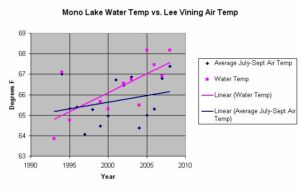
I just read Bartshe’s post about the NASA study showing that Mono Lake’s July-September surface temperature warmed about 4 degrees from 64 degrees F in 1992 to 68.3 degrees F in 2008. The article suggests comparing the water temperatures with air temperatures, and I have just done that with the results shown below.


The graph shows that in 1993 the water surface temperature of Mono Lake would be 0.4F cooler than the air temperature in Lee Vining, and in 2008 the water would be 1.4F warmer than the air. This is an increase of 1F for the air and 2.7F for the water–the water is warming almost 3 times faster than the air.
For this analysis I took average Lee Vining air temperatures for July, August, and September of each year and compared it to the ATSR points from the graph posted in the water temperature article. For all the years with water temperature data, Mono Lake was meromictic (chemically stratified the previous winter) except in 1993, 1994, 1995, 2004, 2005, and 2008. In these years the lake fully mixed the previous winter, allowing the full water column temperature to equalize with the winter air temperature.
The interesting thing about this study is that this means that the surface water is warming faster than the air at an increasing rate each year–it is not a multi-year effect since Mono Lake in those years mentioned above fully mixed in the winter. This assumes that winter air temperatures are not warming faster than summertime air temperatures–worth checking. Dr. Robert Jellison with UCSB has over 25 years of temperature data for Mono Lake (along with an air temperature station on Paoha Island), and it would be interesting to see how his water temperature data compare to the satellite data in the study. Also interesting would be to compare these temperatures with annual runoff to the lake–a year like 1995 with a lot of cold water running into the lake in summer would have a major effect.
Another interesting thing is that September air temperature is often much colder than July-August. But since the lake retains heat (as described in the Sac Bee article), I wondered how much September temperatures (when the water is almost always warmer than the air) are affecting this. I just looked at September vs. July-August air temperatures, and September is cooling! Relative to July-August, in 1993, September average air temperature in Lee Vining would have been 6.6F colder than July-August, but in 2008 it would have been 10F colder (based on the trend). September average air temperature is trending from 61.3F in 1994 to 59.1F in 2008. This means that July-August temperatures are rising even faster than the July-September average would lead one to believe. In fact, July-August Lee Vining average air temperatures rose 2.5F during the period–much faster than the 1 degree rise in summer air temperatures mentioned above that included September’s 2.2 degree cooling.
Note that the NASA study is a short term (12-year) study, and my additional look at air temperatures filled in some missing years but is still short, so all these conclusions are based on only 12-15 years of data. Also note that running the air temperature analysis with the missing water temperature months included results in big changes and additional warming–so the NASA study could be an underestimate. But there is still great value in this study–it demonstrates the value of remote sensing of lake temperatures, and it causes us to ask additional questions, which eventually lead to further studies with more conclusive results. Right now, from this data, we can say that it appears that during the last 15 years, July and August air temperatures are warming and September is cooling, and Mono Lake’s summertime surface water temperature appears to be rising at an even faster rate than the air.
